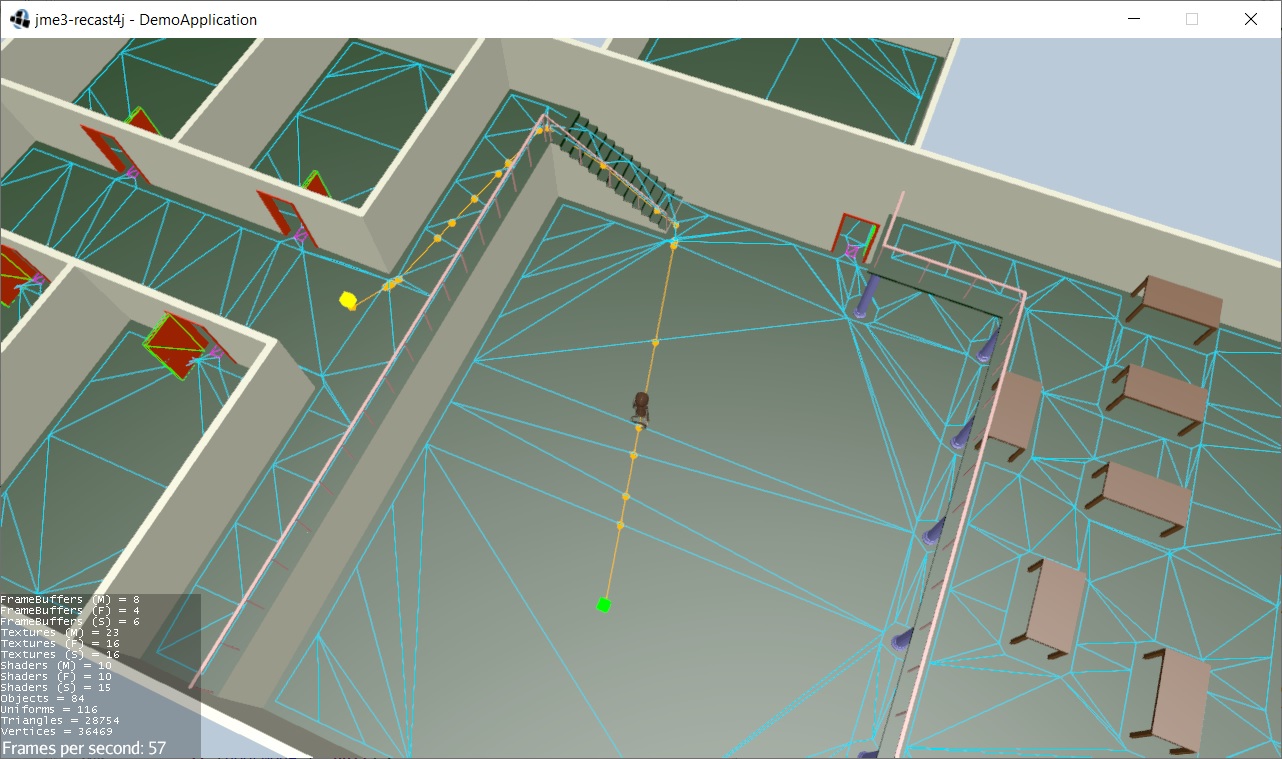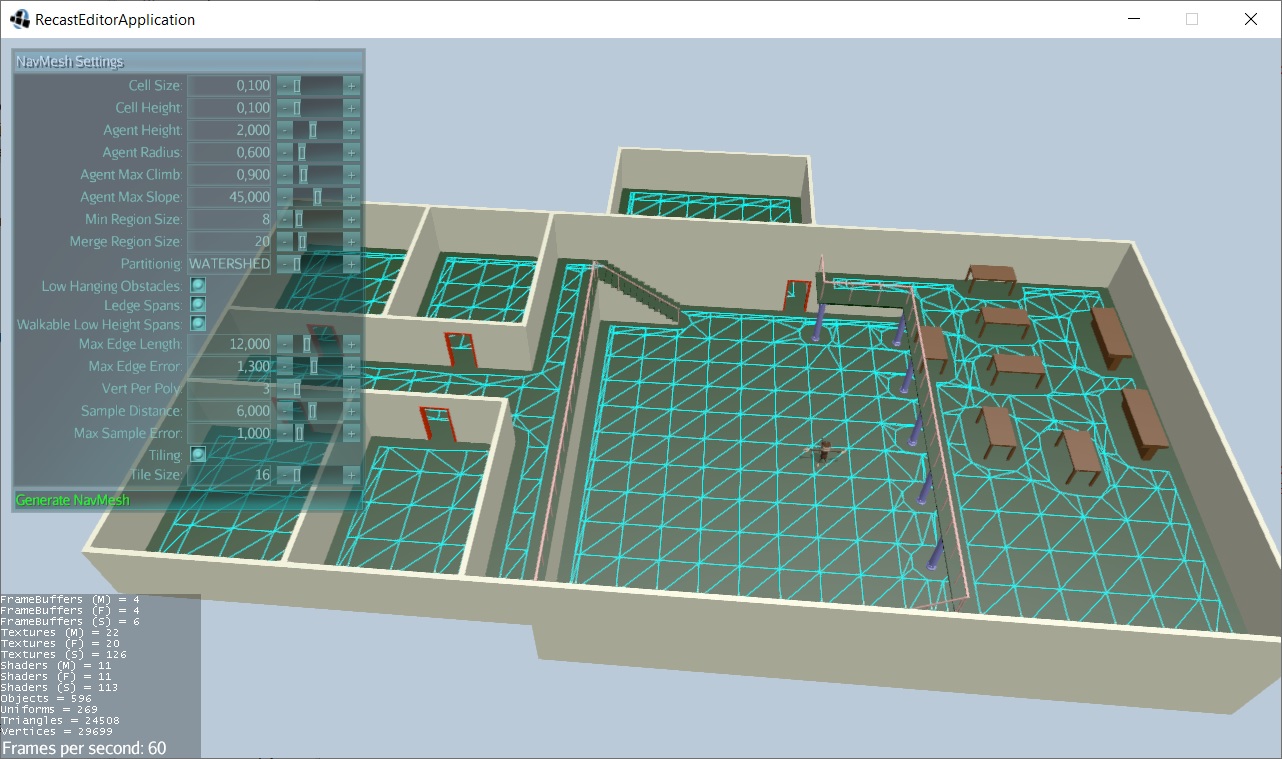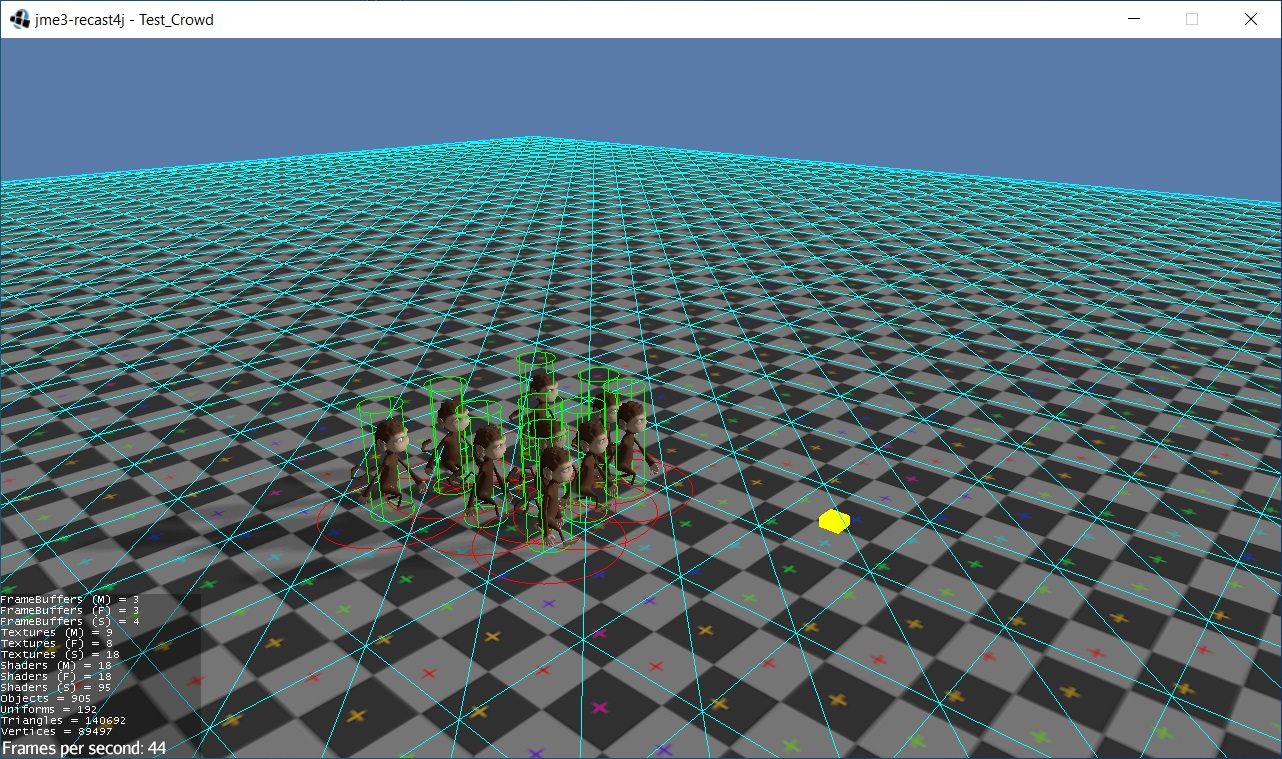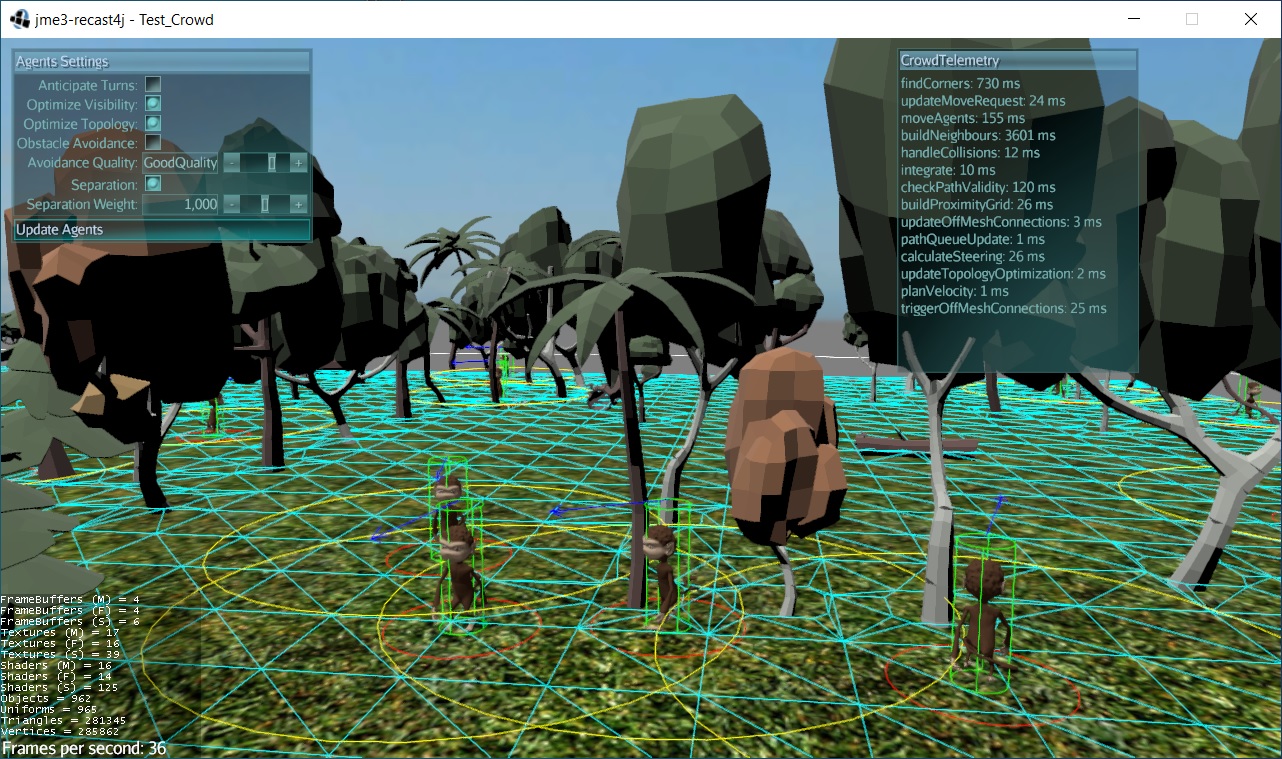if (m_partitionType == PartitionType.WATERSHED) {
// Prepare for region partitioning, by calculating distance field
// along the walkable surface.
RecastRegion.buildDistanceField(m_ctx, m_chf);
// Partition the walkable surface into simple regions without holes.
RecastRegion.buildRegions(m_ctx, m_chf, m_borderSize, cfg.minRegionArea, cfg.mergeRegionArea);
} else if (m_partitionType == PartitionType.MONOTONE) {
// Partition the walkable surface into simple regions without holes.
// Monotone partitioning does not need distancefield.
RecastRegion.buildRegionsMonotone(m_ctx, m_chf, m_borderSize, cfg.minRegionArea, cfg.mergeRegionArea);
} else {
// Partition the walkable surface into simple regions without holes.
RecastRegion.buildLayerRegions(m_ctx, m_chf, m_borderSize, cfg.minRegionArea);
}
// Step 5. Trace and simplify region contours.
// Create contours.
ContourSet m_cset = RecastContour.buildContours(m_ctx, m_chf, cfg.maxSimplificationError, cfg.maxEdgeLen, RecastConstants.RC_CONTOUR_TESS_WALL_EDGES);
// Step 6. Build polygons mesh from contours.
// Build polygon navmesh from the contours.
PolyMesh m_pmesh = RecastMesh.buildPolyMesh(m_ctx, m_cset, cfg.maxVertsPerPoly);
// Step 7. Create detail mesh which allows to access approximate height
// on each polygon.
PolyMeshDetail m_dmesh = RecastMeshDetail.buildPolyMeshDetail(m_ctx,
m_pmesh, m_chf, cfg.detailSampleDist, cfg.detailSampleMaxError);
long time2 = System.nanoTime() - time1;
System.out.println(exportFilename + " : " + m_partitionType + " "
+ TimeUnit.SECONDS.convert(time2, TimeUnit.NANOSECONDS) + " s");
exportObj(exportFilename.substring(0, exportFilename.lastIndexOf('.'))
+ "_debug.obj", m_dmesh);
//must set flags for navigation controls to work
for (int i = 0; i < m_pmesh.npolys; ++i) {
m_pmesh.flags[i] = SampleAreaModifications.SAMPLE_POLYFLAGS_WALK;
}
// NavMeshDataCreateParams params = new NavMeshDataCreateParams();
NavMeshDataCreateParams params = new NavMeshDataParameters();
params.verts = m_pmesh.verts;
params.vertCount = m_pmesh.nverts;
params.polys = m_pmesh.polys;
params.polyAreas = m_pmesh.areas;
params.polyFlags = m_pmesh.flags;
params.polyCount = m_pmesh.npolys;
params.nvp = m_pmesh.nvp;
params.detailMeshes = m_dmesh.meshes;
params.detailVerts = m_dmesh.verts;
params.detailVertsCount = m_dmesh.nverts;
params.detailTris = m_dmesh.tris;
params.detailTriCount = m_dmesh.ntris;
params.walkableHeight = m_agentHeight;
params.walkableRadius = m_agentRadius;
params.walkableClimb = m_agentMaxClimb;
params.bmin = m_pmesh.bmin;
params.bmax = m_pmesh.bmax;
params.cs = m_cellSize;
params.ch = m_cellHeight;
params.buildBvTree = true;
MeshData meshData = NavMeshBuilder.createNavMeshData(params);
navMesh = new NavMesh(meshData, params.nvp, 0);
//create object to save solo NavMesh parameters
MeshParameters meshParams = new MeshParameters();
meshParams.addMeshDataParameters((NavMeshDataParameters) params);
//save NavMesh parameters as .j3o
saveNavMesh(meshParams, exportFilename.substring(0, exportFilename.lastIndexOf('.'))
+ "_solo_C" + m_tileSize);
//display NavMesh.obj
// showDebugMesh("Scenes/Recast/recastmesh_debug.obj", ColorRGBA.Green);
//save as obj no normals
// saveObj(exportFilename.substring(0, exportFilename.lastIndexOf('.')) + "_solo_" + m_partitionType + "_C" + m_tileSize + "_detail.obj", m_dmesh);
saveObj(exportFilename.substring(0, exportFilename.lastIndexOf('.')) + "_solo_" + m_partitionType + "_C" + m_tileSize + ".obj", m_pmesh);
//save as obj with normals
exportObj(exportFilename.substring(0, exportFilename.lastIndexOf('.')) + "_solo_" + m_partitionType + "_C" + m_tileSize + "_detail.obj", m_dmesh);
}
private void tiledNavMeshBuilder() {
Mesh mesh = new Mesh();
GeometryBatchFactory.mergeGeometries(findGeometries(app.getRootNode(),
new LinkedList<>()), mesh);
List<Float> vertexPositions = getVertices(mesh);
List<Integer> indices = getIndices(mesh);
InputGeomProvider geom = new SimpleInputGeomProvider(vertexPositions, indices);
long time1 = System.nanoTime();
// Initialize build config.
RecastConfig cfg = new RecastConfig(m_partitionType, m_cellSize,
m_cellHeight, m_agentHeight, m_agentRadius,
m_agentMaxClimb, m_agentMaxSlope, m_regionMinSize,
m_regionMergeSize, m_edgeMaxLen, m_edgeMaxError,
m_vertsPerPoly, m_detailSampleDist, m_detailSampleMaxError,
m_tileSize, SampleAreaModifications.SAMPLE_AREAMOD_GROUND);
// Build all tiles
// RecastBuilder builder = new RecastBuilder();
// time3 = System.nanoTime();
//uses listener param (this)
RecastBuilder builder = new RecastBuilder(new ProgressListen());
//use listener when calling buildTiles
RecastBuilderResult[][] rcResult = builder.buildTiles(geom, cfg, 1);
long time2 = System.nanoTime() - time1;
System.out.println(exportFilename + " : " + m_partitionType + " "
+ TimeUnit.SECONDS.convert(time2, TimeUnit.NANOSECONDS) + " s");
// Add tiles to nav mesh
int tw = rcResult.length;
int th = rcResult[0].length;
// Create empty nav mesh
// NavMeshParams navMeshParams = new NavMeshParams();
NavMeshParams navMeshParams = new NavMeshParameters();
copy(navMeshParams.orig, geom.getMeshBoundsMin());
navMeshParams.tileWidth = m_tileSize * m_cellSize;
navMeshParams.tileHeight = m_tileSize * m_cellSize;
navMeshParams.maxTiles = tw * th;
navMeshParams.maxPolys = 32768;
//Create object to save NavMeshParameters for tiled NavMesh
MeshParameters meshParams = new MeshParameters();
meshParams.addMeshParameters((NavMeshParameters) navMeshParams);
navMesh = new NavMesh(navMeshParams, 6);
List<PolyMeshDetail> dmeshList = new ArrayList<>();
for (int y = 0; y < th; y++) {
for (int x = 0; x < tw; x++) {
PolyMesh pmesh = rcResult[x][y].getMesh();
if (pmesh.npolys == 0) {
continue;
}
for (int i = 0; i < pmesh.npolys; ++i) {
pmesh.flags[i] = 1;
}
// NavMeshDataCreateParams params = new NavMeshDataCreateParams();
NavMeshDataCreateParams params = new NavMeshDataParameters();
params.verts = pmesh.verts;
params.vertCount = pmesh.nverts;
params.polys = pmesh.polys;
params.polyAreas = pmesh.areas;
params.polyFlags = pmesh.flags;
params.polyCount = pmesh.npolys;
params.nvp = pmesh.nvp;
PolyMeshDetail dmesh = rcResult[x][y].getMeshDetail();
dmeshList.add(dmesh);
params.detailMeshes = dmesh.meshes;
params.detailVerts = dmesh.verts;
params.detailVertsCount = dmesh.nverts;
params.detailTris = dmesh.tris;
params.detailTriCount = dmesh.ntris;
params.walkableHeight = m_agentHeight;
params.walkableRadius = m_agentRadius;
params.walkableClimb = m_agentMaxClimb;
params.bmin = pmesh.bmin;
params.bmax = pmesh.bmax;
params.cs = m_cellSize;
params.ch = m_cellHeight;
params.tileX = x;
params.tileY = y;
params.buildBvTree = true;
navMesh.addTile(NavMeshBuilder.createNavMeshData(params), 0, 0);
//Add parameters to the
meshParams.addMeshDataParameters((NavMeshDataParameters) params);
}
}
//save NavMesh parameters as .j3o
saveNavMesh(meshParams, exportFilename.substring(0, exportFilename.lastIndexOf('.'))
+ "_tiled_C" + m_tileSize);
//save NavMesh as .obj
exportObj(exportFilename.substring(0, exportFilename.lastIndexOf('.'))
+ "_tiled_C" + m_tileSize + ".obj", dmeshList);
//display NavMesh.obj
// showDebugMesh("Scenes/Recast/recastmesh_tiled64_debug.obj", ColorRGBA.Green);
}
//Merges terrain meshes into one mesh.
public Mesh terrain2mesh(Terrain terr) {
float[] heights = terr.getHeightMap();
int length = heights.length;
int side = (int) FastMath.sqrt(heights.length);
float[] vertices = new float[length * 3];
int[] indices = new int[(side - 1) * (side - 1) * 6];
// Vector3f trans = ((Node) terr).getWorldTranslation().clone();
Vector3f trans = new Vector3f(0, 0, 0);
trans.x -= terr.getTerrainSize() / 2.0f;
trans.z -= terr.getTerrainSize() / 2.0f;
float offsetX = trans.x;
float offsetZ = trans.z;
// do vertices
int i = 0;
for (int z = 0; z < side; z++) {
for (int x = 0; x < side; x++) {
vertices[i++] = x + offsetX;
vertices[i++] = heights[z * side + x];
vertices[i++] = z + offsetZ;
}
}
// do indexes
i = 0;
for (int z = 0; z < side - 1; z++) {
for (int x = 0; x < side - 1; x++) {
// triangle 1
indices[i++] = z * side + x;
indices[i++] = (z + 1) * side + x;
indices[i++] = (z + 1) * side + x + 1;
// triangle 2
indices[i++] = z * side + x;
indices[i++] = (z + 1) * side + x + 1;
indices[i++] = z * side + x + 1;
}
}
Mesh mesh2 = new Mesh();
mesh2.setBuffer(VertexBuffer.Type.Position, 3, vertices);
mesh2.setBuffer(VertexBuffer.Type.Index, 3, indices);
mesh2.updateBound();
mesh2.updateCounts();
return mesh2;
}
//Gathers all geometries in supplied node into supplied List. Uses
//terrain2mesh to merge found Terrain meshes into one geometry prior to
//adding. Scales and sets translation of merged geometry.
private List<Geometry> findGeometries(Node node, List<Geometry> geoms) {
for (Iterator<Spatial> it = node.getChildren().iterator(); it.hasNext();) {
Spatial spatial = it.next();
if (!spatial.getName().equals("Sky")
&& !spatial.getName().equals("water")
&& !spatial.getName().equals("NavMesh")
&& !spatial.getName().equals("TerrainA")
&& !spatial.getName().equals("TerrainB")
&& !spatial.getName().equals("terrain-terrainC")
/* && !spatial.getName().equals("Terrain_C")*/
&& !spatial.getName().equals("terrainD")
/*&& !spatial.getName().equals("Neo")
&& !spatial.getName().equals("Platform")
&& !spatial.getName().equals("Stairs")
&& !spatial.getName().equals("Stairs90")
&& !spatial.getName().equals("Stairs180")
&& !spatial.getName().equals("StairPlat180")
&& !spatial.getName().equals("Table")
&& !spatial.getName().equals("Ramp")*/) {
if (spatial instanceof Geometry) {
Mesh clone = ((Geometry) spatial).getMesh().clone();
Geometry g = new Geometry("merged" + spatial.getName());
g.setMesh(clone);
g.setLocalScale(spatial.getWorldScale());
g.setLocalRotation(spatial.getWorldRotation());
g.setLocalTranslation(spatial.getWorldTranslation().subtract(new Vector3f(0, m_cellHeight, 0)));
geoms.add(g);
// geoms.add((Geometry) spatial);
System.out.println("findGeometries " + spatial.getName());
} else if (spatial instanceof Node) {
if (spatial instanceof Terrain) {
//create new merged mesh
Mesh merged = terrain2mesh((Terrain) spatial);
Geometry g = new Geometry("merged" + spatial.getName());
g.setMesh(merged);
g.setLocalScale(spatial.getLocalScale());
//must offset due to terrain2mesh offsetting
g.setLocalTranslation(spatial.getLocalTranslation().subtract(new Vector3f(-0.5f, m_cellHeight, -0.5f)));
geoms.add(g);
System.out.println("findGeometries " + spatial.getName());
} else {
findGeometries((Node) spatial, geoms);
}
}
}
}
// System.out.println(geoms);
return geoms;
}
/**
* Get vertcices of a mesh boxed to Float.
*
* @param mesh
* @return Returns boxed List of vertices.
*/
private List<Float> getVertices(Mesh mesh) {
FloatBuffer buffer = mesh.getFloatBuffer(VertexBuffer.Type.Position);
float[] vertexArray = BufferUtils.getFloatArray(buffer);
List<Float> vertexList = new ArrayList<>();
for (float vertex : vertexArray) {
vertexList.add(vertex);
}
return vertexList;
}
/**
* Get all triangles from a mesh boxed to Integer.
*
* @param mesh
* @return Returns boxed List of triangles.
*/
private List<Integer> getIndices(Mesh mesh) {
int[] indices = new int[3];
Integer[] triangles = new Integer[mesh.getTriangleCount() * 3];
for (int i = 0; i < triangles.length; i += 3) {
mesh.getTriangle(i / 3, indices);
triangles[i] = indices[0];
triangles[i + 1] = indices[1];
triangles[i + 2] = indices[2];
}
//Independent copy so Arrays.asList is garbage collected
return new ArrayList<>(Arrays.asList(triangles));
}
private Vector3f[] getVector3Array(PolyMeshDetail dmesh) {
Vector3f[] vector3Array = new Vector3f[dmesh.nverts];
for (int i = 0; i < dmesh.nverts; i++) {
vector3Array[i] = new Vector3f(dmesh.verts[i * 3],
dmesh.verts[i * 3 + 1], dmesh.verts[i * 3 + 2]);
}
return vector3Array;
}
//export obj no normals
private void saveObj(String filename, PolyMesh mesh) {
try {
File file = new File(filename);
FileWriter fw = new FileWriter(file);
for (int v = 0; v < mesh.nverts; v++) {
fw.write("v " + (mesh.bmin[0] + mesh.verts[v * 3] * mesh.cs) + " "
+ (mesh.bmin[1] + mesh.verts[v * 3 + 1] * mesh.ch) + " "
+ (mesh.bmin[2] + mesh.verts[v * 3 + 2] * mesh.cs) + "\n");
}
for (int i = 0; i < mesh.npolys; i++) {
int p = i * mesh.nvp * 2;
fw.write("f ");
for (int j = 0; j < mesh.nvp; ++j) {
int v = mesh.polys[p + j];
if (v == RC_MESH_NULL_IDX)
break;
fw.write((v + 1) + " ");
}
fw.write("\n");
}
fw.close();
} catch (Exception e) {
}
}
//export obj no normals
private void saveObj(String filename, PolyMeshDetail dmesh) {
try {
File file = new File(filename);
FileWriter fw = new FileWriter(file);
for (int v = 0; v < dmesh.nverts; v++) {
fw.write("v " + dmesh.verts[v * 3] + " "
+ dmesh.verts[v * 3 + 1] + " "
+ dmesh.verts[v * 3 + 2] + "\n");
}
for (int m = 0; m < dmesh.nmeshes; m++) {
int vfirst = dmesh.meshes[m * 4];
int tfirst = dmesh.meshes[m * 4 + 2];
for (int f = 0; f < dmesh.meshes[m * 4 + 3]; f++) {
fw.write("f " + (vfirst + dmesh.tris[(tfirst + f) * 4] + 1) + " "
+ (vfirst + dmesh.tris[(tfirst + f) * 4 + 1] + 1) + " "
+ (vfirst + dmesh.tris[(tfirst + f) * 4 + 2] + 1) + "\n");
}
}
fw.close();
} catch (Exception e) {
}
}
//export obj with normals
private void exportObj(String filename, PolyMeshDetail dmesh) {
File file = new File(filename);
File dir = file.getParentFile();
if (!dir.exists()) {
dir.mkdir();
}
try (FileWriter out = new FileWriter(file)) {
//vertex
for (int v = 0; v < dmesh.nverts; v++) {
out.write("v " + dmesh.verts[v * 3] + " "
+ dmesh.verts[v * 3 + 1] + " "
+ dmesh.verts[v * 3 + 2] + "\n");
}
//vertex normal
Vector3f[] vector3Array = getVector3Array(dmesh);
for (int m = 0; m < dmesh.nmeshes; m++) {
int vfirst = dmesh.meshes[m * 4];
int tfirst = dmesh.meshes[m * 4 + 2];
for (int f = 0; f < dmesh.meshes[m * 4 + 3]; f++) {
Vector3f normal = Triangle.computeTriangleNormal(
vector3Array[(vfirst + dmesh.tris[(tfirst + f) * 4])],
vector3Array[(vfirst + dmesh.tris[(tfirst + f) * 4
+ 1])],
vector3Array[(vfirst + dmesh.tris[(tfirst + f) * 4
+ 2])],
null);
out.write("vn " + normal.x + " " + normal.y + " " + normal.z
+ "\n");
}
}
//face
int count = 1;
for (int m = 0; m < dmesh.nmeshes; m++) {
int vfirst = dmesh.meshes[m * 4];
int tfirst = dmesh.meshes[m * 4 + 2];
for (int f = 0; f < dmesh.meshes[m * 4 + 3]; f++) {
out.write("f "
+ (vfirst + dmesh.tris[(tfirst + f) * 4] + 1)
+ "//" + count + " "
+ (vfirst + dmesh.tris[(tfirst + f) * 4 + 1] + 1)
+ "//" + count + " "
+ (vfirst + dmesh.tris[(tfirst + f) * 4 + 2] + 1)
+ "//" + count + "\n");
count++;
}
}
out.close();
} catch (IOException ex) {
LOG.log(Level.SEVERE, null, ex);
}
}
//export obj with normals
private void exportObj(String filename, RecastBuilderResult[][] rcResult) {
File file = new File(filename);
File dir = file.getParentFile();
if (!dir.exists()) {
dir.mkdir();
}
try (FileWriter out = new FileWriter(file)) {
//vertex
int tw = rcResult.length;
int th = rcResult[0].length;
for (int i = 0; i < tw; i++) {
for (int j = 0; j < th; j++) {
PolyMesh pmesh = rcResult[i][j].getMesh();
if (pmesh.npolys == 0) {
continue;
}
PolyMeshDetail dmesh = rcResult[i][j].getMeshDetail();
for (int v = 0; v < dmesh.nverts; v++) {
out.write("v " + dmesh.verts[v * 3] + " "
+ dmesh.verts[v * 3 + 1] + " "
+ dmesh.verts[v * 3 + 2] + "\n");
}
}
}
//vertex normal
for (int i = 0; i < tw; i++) {
for (int j = 0; j < th; j++) {
PolyMesh pmesh = rcResult[i][j].getMesh();
if (pmesh.npolys == 0) {
continue;
}
PolyMeshDetail dmesh = rcResult[i][j].getMeshDetail();
Vector3f[] vector3Array = getVector3Array(dmesh);
for (int m = 0; m < dmesh.nmeshes; m++) {
int vfirst = dmesh.meshes[m * 4];
int tfirst = dmesh.meshes[m * 4 + 2];
for (int f = 0; f < dmesh.meshes[m * 4 + 3]; f++) {
Vector3f normal = Triangle.computeTriangleNormal(
vector3Array[(vfirst + dmesh.tris[(tfirst
+ f) * 4])],
vector3Array[(vfirst + dmesh.tris[(tfirst
+ f) * 4 + 1])],
vector3Array[(vfirst + dmesh.tris[(tfirst
+ f) * 4 + 2])],
null);
out.write("vn " + normal.x + " " + normal.y + " "
+ normal.z + "\n");
}
}
}
}
//face
int count = 1;
int offset = 0;
for (int i = 0; i < tw; i++) {
for (int j = 0; j < th; j++) {
PolyMesh pmesh = rcResult[i][j].getMesh();
if (pmesh.npolys == 0) {
continue;
}
PolyMeshDetail dmesh = rcResult[i][j].getMeshDetail();
for (int m = 0; m < dmesh.nmeshes; m++) {
int vfirst = dmesh.meshes[m * 4];
int tfirst = dmesh.meshes[m * 4 + 2];
for (int f = 0; f < dmesh.meshes[m * 4 + 3]; f++) {
out.write("f "
+ ((vfirst + dmesh.tris[(tfirst + f) * 4]
+ 1) + offset)
+ "//" + count + " "
+ ((vfirst
+ dmesh.tris[(tfirst + f) * 4 + 1] + 1)
+ offset)
+ "//" + count + " "
+ ((vfirst
+ dmesh.tris[(tfirst + f) * 4 + 2] + 1)
+ offset)
+ "//" + count + "\n");
count++;
}
}
offset += dmesh.nverts;
}
}
out.close();
} catch (IOException ex) {
LOG.log(Level.SEVERE, null, ex);
}
}
//Exports a List of detailed meshes to .obj format with normals.
private void exportObj(String filename, List<PolyMeshDetail> dmeshList) {
File file = new File(filename);
File dir = file.getParentFile();
if (!dir.exists()) {
dir.mkdir();
}
try (FileWriter out = new FileWriter(file)) {
//vertex
for (int j = 0; j < dmeshList.size(); j++) {
PolyMeshDetail dmesh = dmeshList.get(j);
for (int v = 0; v < dmesh.nverts; v++) {
out.write("v " + dmesh.verts[v * 3] + " "
+ dmesh.verts[v * 3 + 1] + " "
+ dmesh.verts[v * 3 + 2] + "\n");
}
}
//vertex normal
for (int j = 0; j < dmeshList.size(); j++) {
PolyMeshDetail dmesh = dmeshList.get(j);
Vector3f[] vector3Array = getVector3Array(dmesh);
for (int m = 0; m < dmesh.nmeshes; m++) {
int vfirst = dmesh.meshes[m * 4];
int tfirst = dmesh.meshes[m * 4 + 2];
for (int f = 0; f < dmesh.meshes[m * 4 + 3]; f++) {
Vector3f normal = Triangle.computeTriangleNormal(
vector3Array[(vfirst + dmesh.tris[(tfirst + f)
* 4])],
vector3Array[(vfirst + dmesh.tris[(tfirst + f)
* 4 + 1])],
vector3Array[(vfirst + dmesh.tris[(tfirst + f)
* 4 + 2])],
null);
out.write("vn " + normal.x + " " + normal.y + " "
+ normal.z + "\n");
}
}
}
//face
int count = 1;
int offset = 0;
for (int j = 0; j < dmeshList.size(); j++) {
PolyMeshDetail dmesh = dmeshList.get(j);
for (int m = 0; m < dmesh.nmeshes; m++) {
int vfirst = dmesh.meshes[m * 4];
int tfirst = dmesh.meshes[m * 4 + 2];
for (int f = 0; f < dmesh.meshes[m * 4 + 3]; f++) {
out.write("f "
+ ((vfirst + dmesh.tris[(tfirst + f) * 4] + 1)
+ offset)
+ "//" + count + " "
+ ((vfirst + dmesh.tris[(tfirst + f) * 4 + 1]
+ 1) + offset)
+ "//" + count + " "
+ ((vfirst + dmesh.tris[(tfirst + f) * 4 + 2]
+ 1) + offset)
+ "//" + count + "\n");
count++;
}
}
offset += dmesh.nverts;
}
out.close();
} catch (IOException ex) {
LOG.log(Level.SEVERE, null, ex);
}
}
//Exports the Recast NavMesh to assets in .j3o format so can load a
//saved Recast NavMesh rather than building.
private void saveNavMesh(MeshParameters params, String filename) {
BinaryExporter exporter = BinaryExporter.getInstance();
File file = new File(filename + ".j3o");
try {
exporter.save(params, file);
} catch (IOException ex) {
LOG.log(Level.SEVERE, "Error: Failed to save recastMesh!", ex);
}
}
//Exports the Recast NavMesh to assets in .j3o format so can load a
//saved Recast NavMesh rather than building.
private void saveNavMesh(Mesh mesh, String filename) {
Path path = Paths.get("assets" + sep + "Scenes" + sep + "Recast");
BinaryExporter exporter = BinaryExporter.getInstance();
File file = new File(path + sep + filename + ".j3o");
try {
exporter.save(mesh, file);
} catch (IOException ex) {
LOG.log(Level.SEVERE, "Error: Failed to save recastMesh!", ex);
}
}
/**
* Returns a built Recast NavMesh.
*
* @return the generated NavMesh
*/
public NavMesh getNavMesh() {
return navMesh;
}
/**
* Loads and displays the NavMesh.obj for debugging. Uses assetManager() so
* expects the file to live in the assets folder.
*
* @param filename Path of file to be saved
* @param color the color to be used for viewing the NavMesh
*/
public void showDebugMesh(String filename, ColorRGBA color) {
final Geometry meshGeom = (Geometry) getApplication().getAssetManager().loadModel(filename);
Material mat = new Material(getApplication().getAssetManager(), "Common/MatDefs/Misc/Unshaded.j3md");
mat.setColor("Color", color);
mat.getAdditionalRenderState().setWireframe(true);
meshGeom.setMaterial(mat);
meshGeom.setCullHint(CullHint.Never);
app.getRootNode().attachChild(meshGeom);
}
public void showMesh(String filename, ColorRGBA color) {
AssetKey<Mesh> keyLoc = new AssetKey<>(filename);
final Mesh meshGeom = (Mesh) getApplication().getAssetManager().loadAsset(keyLoc);
Geometry geom = new Geometry();
geom.setMesh(meshGeom);
Material mat = new Material(getApplication().getAssetManager(), "Common/MatDefs/Misc/Unshaded.j3md");
mat.setColor("Color", color);
mat.getAdditionalRenderState().setWireframe(true);
geom.setMaterial(mat);
geom.setCullHint(CullHint.Never);
app.getRootNode().attachChild(geom);
}
private class ProgressListen implements RecastBuilderProgressListener {
private long time = System.nanoTime();
private long elapsedTime;
private long avBuildTime;
private long estTotalTime;
private long estTimeRemain;
private long buildTimeNano;
private long elapsedTimeHr;
private long elapsedTimeMin;
private long elapsedTimeSec;
private long totalTimeHr;
private long totalTimeMin;
private long totalTimeSec;
private long timeRemainHr;
private long timeRemainMin;
private long timeRemainSec;
@Override
public void onProgress(int completed, int total) {
elapsedTime += System.nanoTime() - time;
avBuildTime = elapsedTime/(long)completed;
estTotalTime = avBuildTime * (long)total;
estTimeRemain = estTotalTime - elapsedTime;
buildTimeNano = TimeUnit.MILLISECONDS.convert(avBuildTime, TimeUnit.NANOSECONDS);
System.out.printf("Completed %d[%d] Average [%dms] ", completed, total, buildTimeNano);
elapsedTimeHr = TimeUnit.HOURS.convert(elapsedTime, TimeUnit.NANOSECONDS) % 24;
elapsedTimeMin = TimeUnit.MINUTES.convert(elapsedTime, TimeUnit.NANOSECONDS) % 60;
elapsedTimeSec = TimeUnit.SECONDS.convert(elapsedTime, TimeUnit.NANOSECONDS) % 60;
System.out.printf("Elapsed Time [%02d:%02d:%02d] ", elapsedTimeHr, elapsedTimeMin, elapsedTimeSec);
totalTimeHr = TimeUnit.HOURS.convert(estTotalTime, TimeUnit.NANOSECONDS) % 24;
totalTimeMin = TimeUnit.MINUTES.convert(estTotalTime, TimeUnit.NANOSECONDS) % 60;
totalTimeSec = TimeUnit.SECONDS.convert(estTotalTime, TimeUnit.NANOSECONDS) % 60;
System.out.printf("Estimated Total [%02d:%02d:%02d] ", totalTimeHr, totalTimeMin, totalTimeSec);
timeRemainHr = TimeUnit.HOURS.convert(estTimeRemain, TimeUnit.NANOSECONDS) % 24;
timeRemainMin = TimeUnit.MINUTES.convert(estTimeRemain, TimeUnit.NANOSECONDS) % 60;
timeRemainSec = TimeUnit.SECONDS.convert(estTimeRemain, TimeUnit.NANOSECONDS) % 60;
System.out.printf("Remaining Time [%02d:%02d:%02d]%n", timeRemainHr, timeRemainMin, timeRemainSec);
//reset time
time = System.nanoTime();
}
}
}

 thats nice.
thats nice.












